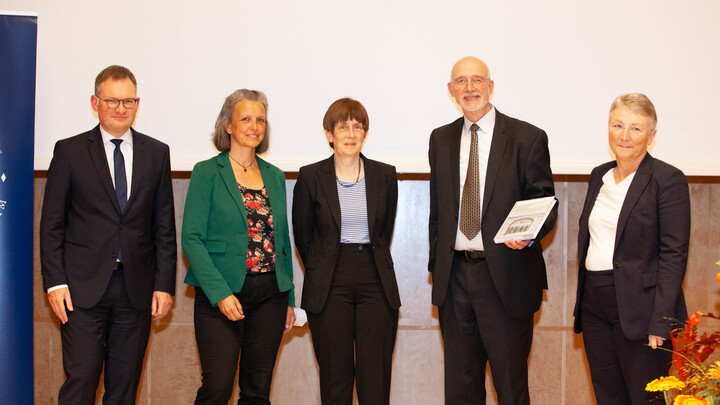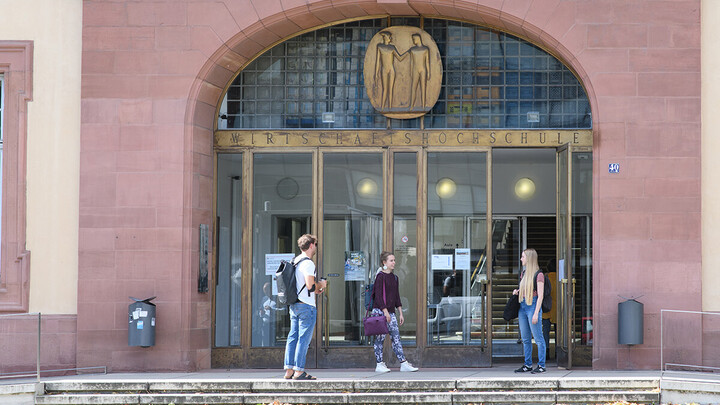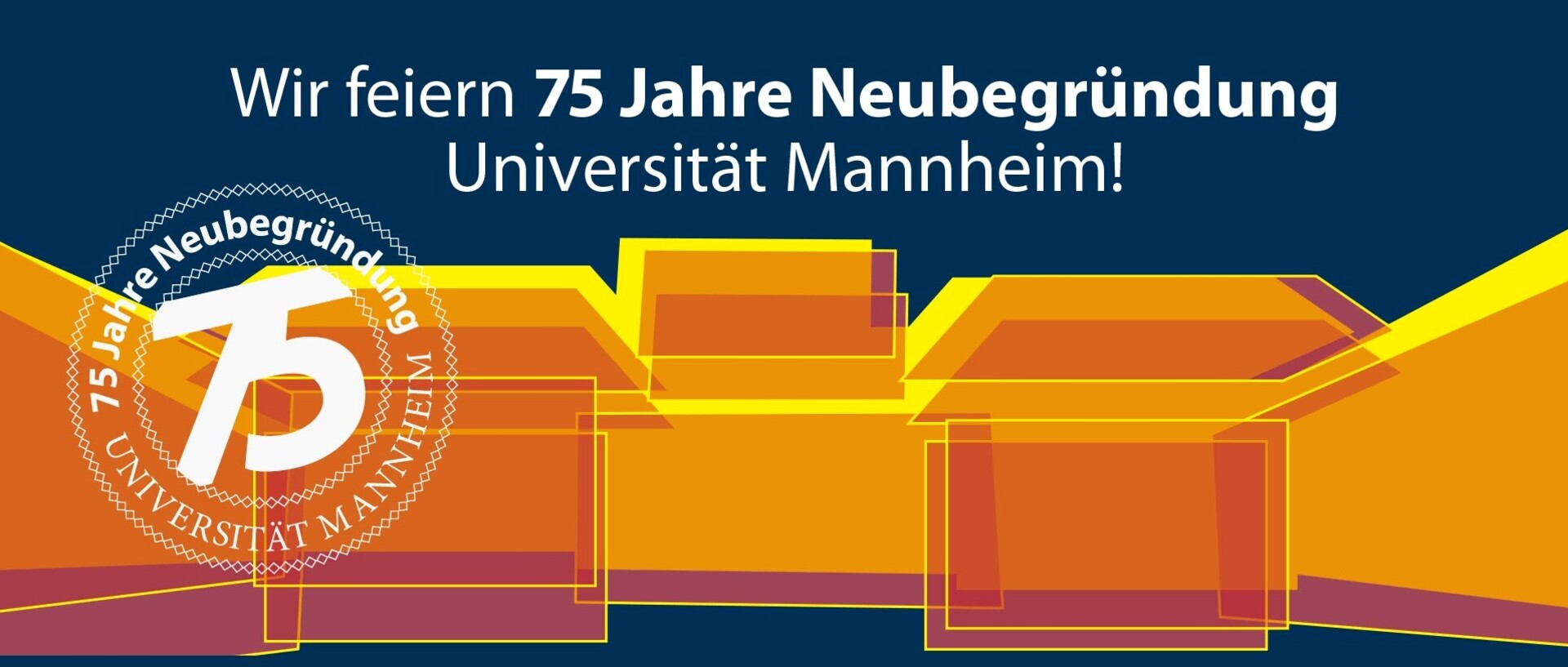“We Have Become a University for Society”

The university’s roots go back to the Handelshochschule that was founded in 1907 and re-established as Wirtschaftshochschule after the Second World War. In October, the university celebrates the 75th anniversary of re-establishing the Wirtschaftshochschule. In our interview, the main authors of the festschrift Eine Universität für die Gesellschaft. 75 Jahre Neubegründung Wirtschaftshochschule und Universität Mannheim (“A university for society. 75th anniversary of re-establishing the Wirtschaftshochschule and the University of Mannheim.”), Dr. Sandra Eichfelder, Professor Dr. Angela Borgstedt, and Professor Dr. Philipp Gassert, talk about the milestones and challenges in the course of history.

This year, we celebrate the re-establishment of the Wirtschaftshochschule Mannheim. How did it come that the Wirtschaftshochschule was re-established 75 years ago?
Eichfelder: The Handelshochschule that had been founded in 1907 was dissolved in 1933 when the Nazis took over. In 1945, it became part of Heidelberg University, as Staats- und Wirtschaftswissenschaftliche Fakultät (school of economics and political science). When the war ended, Heidelberg University did not wish to keep the programs in business administration that originally belonged to the Handelshochschule Mannheim. In contrast to other programs at Heidelberg University, business administration was seen as a discipline that was not “purely academic”. In addition, the government of the Land of Baden-Württemberg felt that they needed to give something back to Mannheim. This is where Franz Schnabel, who was born in Mannheim and was director of culture and teaching (Landesdirektor für Kultus und Unterricht) at the time, came into play. Schnabel advocated for bringing business administration programs back to Mannheim.
Borgstedt: Yes, Franz Schnabel put a lot of energy into this. As historian, he also offered some of the first courses, although he oversaw the ministry of cultural affairs at the time. In Heidelberg, he lived next to Walter Waffenschmidt, who became the first president of the newly established Wirtschaftshochschule. Schnabel and Waffenschmidt knew each other and this explains their close connection. Together with the mayor of the city of Mannheim, Josef Braun, they formed the trio that organized the opening ceremony of the newly established Wirtschaftshochschule.
Gassert: And the city had very practical reasons for re-establishing the former Handelshochschule as Wirtschaftshochschule. The Wirtschaftshochschule was a public institution, paid for by the government. The original Wirtschaftshochschule had been funded by the city.
What are the most important milestones in the history of the University of Mannheim?
Professor Gassert: In my opinion, four dates are important: 1946, 1967, 1999, and 2006. In 1946, the institution was founded. In 1967, the Wirtschaftshochschule became a university. First, this was part of a general expansion of higher education. At this time, several universities were founded, for example Konstanz, Ulm, Stuttgart, Karlsruhe or Hohenheim. Second, it shows that Mannheim was no longer an institution that only offered a practice-oriented education in business administration and business education. With Social Sciences and Economics, Linguistics and Humanities, as well as Law, great, research-oriented fields had become part of the institution in the 1960s.
In 1999, a new constitution became effective. With the new constitution, the University of Mannheim no longer acted as an extension of the ministry, because the legal situation changed: The higher education institutions became autonomous. Thus, 1999 is also an important year, because Mannheim became the first university in Baden-Württemberg with a constitution that reflects its autonomy. The model used in Mannheim became the standard for all other universities in Baden-Württemberg.
The years between 2005 and 2009 were characterized by the great university dispute. The dispute was a deep crisis that severely affected our school, the School of Humanities. However, it made clear what the University of Mannheim stands for. The process sharpened our profile, but the actors had to face strong headwinds, also from professors. In retrospect, however, it was right – and I say that as dean of the School of Humanities. Sharpening our profile was the basis for the top position we are holding now.
Besides the dispute about the university’s profile, were there any other challenges in the history of the University of Mannheim?
Borgstedt: At the beginning, two issues threatened the newly established Wirtschaftshochschule. At the one hand, there were discussions about combining the institutions in Karlsruhe and Mannheim. Some time later, it was unclear whether the city was still interested in keeping the Wirtschaftshochschule in Mannheim.
In addition, there were some practical challenges: Where should we accommodate the institution?At first, provisional arrangements had to be made until it was possible for the Wirtschaftshochschule to move into a part of the rebuilt Schloss in 1955. Where should the students live? Where do we find staff? The newly established institution needed staff members, but had difficulties in finding staff that was unhampered by the past. In fact, this was visible until the mid-1950s. Often, there was only a list of two candidates when it came to appointing a professor, since applicants were scarce.
Due to the university’s expansion in the 1960s, we had to fill a large number of positions in a very short amount of time. Each semester, ten to twelve new professors had to be appointed. This was also a challenge. One appointments committee followed the other.
Eichfelder: I have two stories to share about the difficulties that we had to face at the beginning. The first post-war president, Waffenschmidt, for example, offered his secretary a room at his private residence as office, since it was not possible to procure coal for heating. So, he said: “You can go to my private residence so that you are not cold while you are at work.” Also, during the reconstruction period, every student had to do hours of work for the university as reconstruction aid.
What was student and campus life like in the early days of the Wirtschaftshochschule? What were the most significant differences compared to today?
Eichfelder: The first thing that comes to mind is the precarious housing situation at the beginning. Of course, it is still difficult for students to find appropriate accommodation today, but living with two people in an eight-square-meter room in an underground bunker with nothing but a cot and a small table – I think that is a big difference compared to today. Another difference is the fact that students still had to pay tuition fees in these early days. This meant that, depending on their social background, not everyone was able to afford to study, and BAföG was only introduced later. In exchange, students were offered scholarships and even so-called “Freitische” (free meals); this means that restaurateurs in the city agreed to provide two students with a free lunch three times a week, for example.
Borgstedt: Also in terms of habitus and bearing, a lot has changed if you compare photographs from the 1950s and 1960s with today. Back then, clothing was much more formal, and some students even attended the lectures in suits. And in the beginning, most of the students were male. From the 1950s on, the body of students became more diverse, more colorful. Very early on, students from Norway came to Mannheim. The global influx of foreign students intensified over the decades.
Gassert: And there is even one more point: Digitization has fundamentally changed teaching and administration, while – at the same time – the bureaucratization of processes and structures has increased, as evidenced by the growing workload associated with examination regulations and module catalogs. And when lectures are held via Zoom nowadays – what we know as online teaching today, also started in the 1990s as teleteaching via data lines.
From the very beginning, it was important to the founders of the Wirtschaftshochschule or later the University of Mannheim that not only full-time students had the opportunity to take courses and that the citizens of Mannheim were able to participate in the university's scientific findings. How has the relationship between the university and society developed over the years?
Eichfelder: Yes, education for the general public was already an important feature during the time of the Handelshochschule Mannheim. There were regular programs of study culminating in a degree, as well as the possibility of attending only part of the relevant lectures or participating in individual lectures as a guest student – as is the case now with our Guest Student and Senior Citizen Program.
Obviously, the relationship with the city was sometimes stronger, sometimes weaker. But it has always been present and has been cultivated through events, such as the President's Ball, which was the forerunner of today's Schlossfest. Reaching out to the region has always been important.
Having a connection to the city was also important after the war because the university had difficulties in finding teachers who were unhampered by the past. Therefore, the university had to strongly rely on fee-based teaching contracts with experts from the municipal sector or the business community. People from business enterprises took on teaching contracts for their particular area of expertise.
Gassert: Originally, the Handelshochschule was established by the city. In 1946, the city and its mayor, Josef Braun, also backed and supported the institution. And when it came to sharpening the university' s profile in 2006, they could again rely on the city's support. The mayor and the city councilors said: “We will not let our university be taken away from us! Neither do we want our university to be turned into a Wirtschaftshochschule again.” When you drive to Mannheim, it says “Universitätsstadt” (university city) on the city sign. In Heidelberg, where I live, there is no such sign, we all know that. In Heidelberg, the existence of the university is taken for granted and is not questioned; in Mannheim, on the contrary, it is not in the same way taken as a matter of course. Of course, Mannheim is perceived as a large industrial city, as a cultural center, yet it is not so much identified with its university; thus, it is crucial for this university to have the city standing behind it.
After all, the university started out as a Wirtschaftshochschule and still is a university with a focus on economics and social sciences. What role did and do the other subjects play for the university's profile?
Gassert: They have taken on a central role, and that is what distinguishes today's university from the Wirtschaftshochschule that was founded in 1946. Even though there was a chair of philosophy right from the start. Back then, Walter Waffenschmidt, the first president of the newly established Wirtschaftshochschule said: “If we train business people, then they should also have some basic education in other areas, they should know languages, geography, history, and a bit of philosophy and that kind of thing.” In other words, it was intended that the students be given a broad education and “be able to think”: However, today the university has made it its mission to study society in all its aspects. Hence the title of the festschrift. It has long been more than just a large Wirtschaftshochschule, and that is evident in all its structures. If you take the English term, you could say that in 1946, we were a business school. Today, we have grown far beyond that, and that has to do with the institution’s expansion in the 1960s, when Social Sciences, Law, Languages, and Humanities were added to the portfolio of subjects. We have become a university for society.
Interview: Katja Bauer, Dr. Maartje Koschorreck / October 2021
